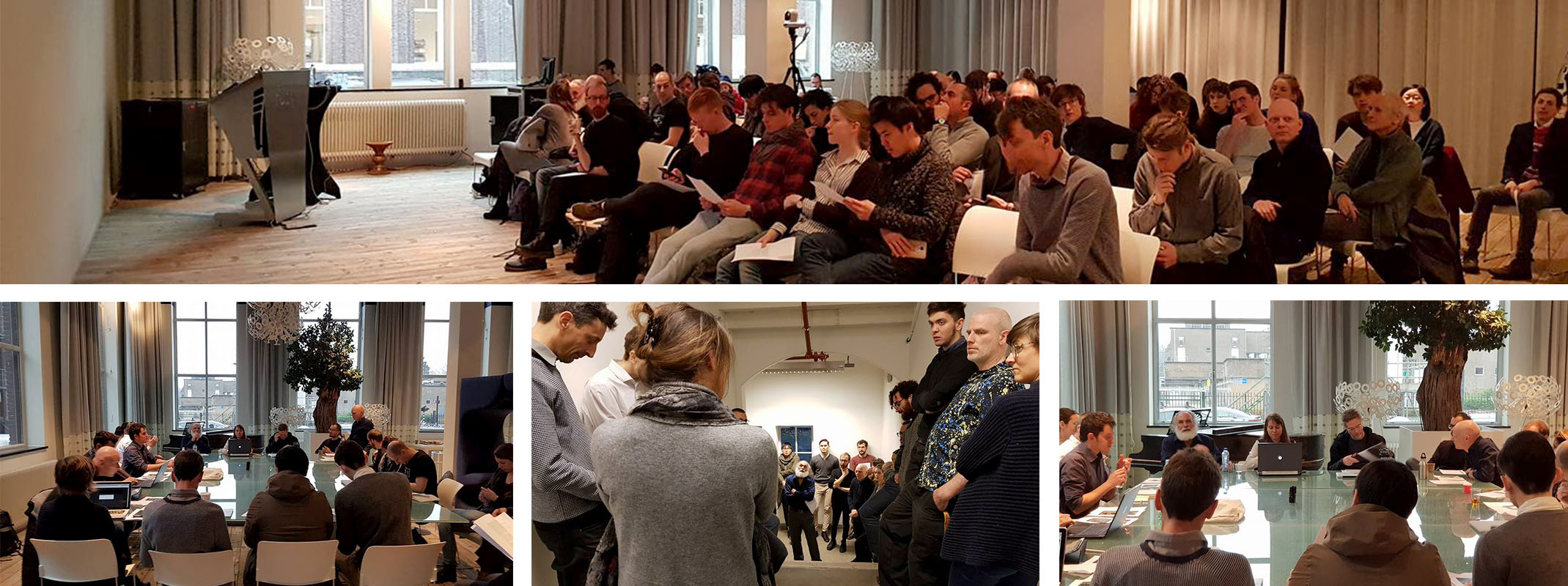Intensive Cartographies
Transdisciplinary Mapping
The Architecture Theory Chair / Ecologies of Architecture as part of its 2017-18 Public Program hosted the Intensive Cartographies series. In these events, the work of scholars, designers and artists were presented and discussed in lectures and roundtable seminars from a transdisciplinary perspective. The events touched upon various concerns surrounding our material world, and the ways in which we experience and map it.

CRTGRPHS1: Mapping the Anthropocene
12 October 2017
In the first event our guests dealt with notions of cartography and mapping in the “age of man and capital” from a variety of angles. Niels Schrader’s ‘(In)convenient Alt Truth: Donald Trump and Al Gore Speech Analyses’ algorithmically compared two speeches that may prove decisive for the faith of the Paris Climate Accord. Sjoerd van Oevelen’s ‘Speculative origins of the Anthropocene and its Consequences for our Visual Faculty as a Geological Force’ exposed the building blocks of our visual faculty. Sybille Lammes’s ‘Mapping Immutable Mobiles: Of Humans and Other Things’ focused on the status of the image as part of digital mapping interfaces.
CRTGRPHS2: Mapping Sonic Space
07 December 2017
The second event explored by ear the universe, its architectures, and our architectonics. Listening to ‘Babel, Bubbles, Burrows, Barrows, Beehives, Bâtiments, Baryons, & Bunraku’, Hillel Schwartz and Raviv Ganchrow addressed the motives, measures, and methods of mapping worlds—and alives—acoustically. An afternoon roundtable with Hillel, Raviv, Marcel Cobussen, and Taufan Ter Weel commenced with calisthenics auditory and ambulatory, moves on to sonicities embodied or theoretic, then quietly reflected on the consequences of taking sound to heart.
CRTGRPHS3: Mapping the Gesture
07 June 2018
In the third event Frans Sturkenboom and Sjoerd van Tuinen explored gesture in architecture. Most topical subjects in contemporary architecture pertain to the surface. Texture, relief, tectonics and even atmosphere – if we free it from its subjectivist form – can be conceptualised as a dramatisation of the surface. The architectural surface is the domain of forces: contortion, the famous ‘twist’, reincarnates the 16th century figura serpentinata. Ressault and rustication show us an imminent world moving towards us, echoing the so-called ‘thrust’ of the inner elevation of Michelangelo’s Bibliotheca Laurenziana. Corrosion hollows out geometry by the sheer multiplication of its figures in a fractal dimension: interiors today appear as spongy matter, as grottos in which earth exhibits a formidable creative force already transforming matter into manner. We have moved from a renaissance of space to a mannerism of the surface. The building as staircase, the wrapped-up square and the street folded into the building: all these complicated sloping floors, enlivening program and intensifying urban space, indicate a clear step towards a virtuoso modernity.
CRTGRPHS4: Mapping Rhythm
11 October 2018
The fourth event explored rhythm in architecture. On October 11th 1978 the exhibition 間 [Ma]. Espace-Temps du Japon, designed by Japanese architect Arata Isozaki, opened its doors in Paris. The Architecture Theory Chair commemorated the 40th anniversary of this exhibition with a public seminar. Isozaki designed nine spatial installations in which [Ma] shows up in different modalities of thought and action. In its architectural context [Ma] shows a moment at which time and space are not disentangled as distinct and abstract notions. [Ma] shows a single sensible spatiotemporal reality characterised by a unique spatial arrangement ‘movement space’ and approach to design ‘co-becoming’. ArtScience students of the Royal Academy of Arts, the Hague, under guidance of artist Cocky Eek, presented their ‘Moment of [Ma]’ in a revisited exhibition. Architect and PhD researcher Renske Maria van Dam, KU Leuven, gave a talk on the potentials of [Ma] for contemporary architectural practice and education.
Facts
| Role TU Delft: | Lead partner |
| Project duration: | October 2017 - October 2018 |
| TU Delft researchers: | Andrej Radman Stavros Kousoulas Heidi Sohn Taufan ter Weel Frans Sturkenboom |
Project partners
Marcel Cobussen (Leiden University), Renske Maria van Dam (KU Leuven), Cocky Eek (Royal Academy of Art in The Hague), Raviv Ganchrow (Royal Conservatoire The Hague), Sybille Lammes (Leiden University), Sjoerd van Oevelen (Leiden University), Niels Schrader (Royal Academy of Art in The Hague), Hillel Schwartz (Independent scholar), Sjoerd van Tuinen (Erasmus University).